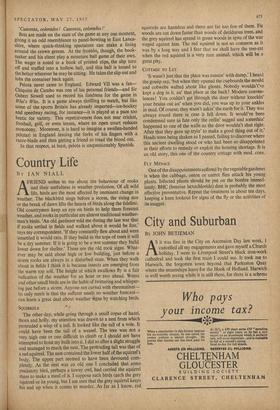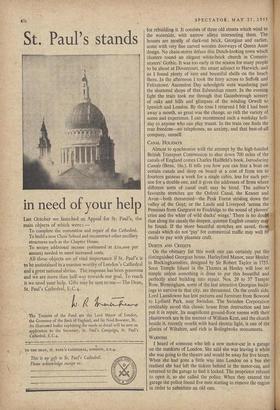City and Suburban
BY JOHN BETJEMAN cancelled all my engagements and gave myself a Church for rebuilding it. It consists of three old streets which wind to the waterside, with narrow alleys intersecting them. The houses are mostly of dark-red brick, Georgian and earlier, some "with very fine carved wooden doorways of Queen Anne design. No chainLstores deface this Dutch-looking town which clusters round an elegant white-brick church in Commis- sioners' Gothic. It was too early in the season for many people to be about at Dovercourt, the smart adjunct to Harwich, and so I found plenty of rare and beautiful shells on the beach there. In the afternoon I 'took the ferry across to Suffolk and Felixstowe. Ascension Day schoolgirls were wandering past the shuttered shops of that Edwardian resort. In the evening light the train took me through that Gainsborough scenery of oaks and hills and glimpses, of the winding Orwell to Ipswich and London. By the time I returned I felt I had been away a month, so great was the change, so rich the variety of scene and experience. I can recommend such a weekday holi- day to anyone who can play truant. In the train one finds the true freedom—no telephones, no anxiety, and that best-of-all company, oneself.
CANAL HOLIDAYS
Almost to synchronise with the attempt by the high-handed British Transport Commission to shut down 700 miles of the canals of England comes Charles Hadfield's book, Introducing Canals (Benn, 16s.). It tells you how you can hire a boat on certain canals and sleep on board at a cost of from ten to fourteen guineas a week for a single cabin, less for each per- son for a double one, and it gives the addresses of firms where different sorts of canal craft may be hired. The author's favourite stretches are the Oxford Canal, the Kennet and Avon—both threatened—the Peak Forest striding down the valley of the Goyt, or the Leeds and Liverpool 'across the Pennines from Gargrave to Foulridge to the sound of plovers' cries and the whirr of wild ducks' wings.' There is no doubt that along the canals the deepest, quietest English country may be found. If the more beautiful stretches are saved, those canals which do not 'pay' for commercial traffic may well be made to pay with pleasure craft.
DEBITS AND CREDITS
On the obituary list this week one can certainly put the distinguished Georgian house, Harleyford Manor, near Henley in Buckinghamshire, designed by Sir Robert Taylor in 1755. Soon Temple Island in the Thames at Henley will, lose its temple unless something is done to put this beautiful and perfectly ,sited building into repair. Nos. 29 to 37 Temple Row, Birmingham, some of the last attractive Georgian build- ings to survive in that city, are threatened. On the credit side, Lord Lansdowne has lent pictures and furniture from Bowood to Lydiard Park, near Swindon. The Swindon Corporation creditably saved this classic house from destruction and has put it in repair. Its magnificent ground-floor rooms with their plasterwork are in the manner of William Kent, and the church beside it, recently overlit with hard electric light, is one of the glories of Wiltshire, and rich in Bolingbroke monuments.
WARNING
I heard of someone who left a new motor-car in a garage on the outskirts of London. She said she was leaving it while she was going to the theatre and would be away for five hours. When she had gone a little way into London on a bus she realised she had left the tickets behind in the motor-can, and returned to the garage to find it locked. The proprietor refused to open it, so she called the police. When they entered the garage the police found five men starting to remove the engine in order to substitute an old one.



































 Previous page
Previous page